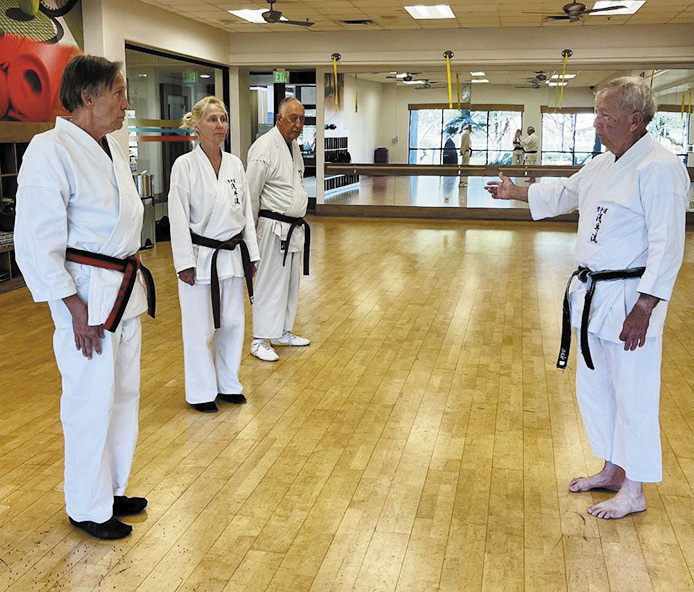
Left to right: Sensei John Evans, Linda Bleisch, and Larry Rowen with Sensei Herum instructing
Shari Rodgers
How does someone go from the humble white belt to the coveted black belt and beyond? Let’s look at the mental and physical challenges that those doing karate face on their journey. Insights into dedication and discipline are required to master karate. Belt testing, promotion standards, and the true meaning of achieving a black belt are learned as we explore karate’s structured path to rank and performance.
Belt System: The belt system was created in the early 1900s to provide a structured path for students to progress. The ranks are divided into “Kyu” grades (colored belts—beginners and intermediates) and “Dan” grades (black belts—advanced practitioners). Advancing through the ranks requires not only technical proficiency and kata performance but also the development of character, discipline, and respect. Earning a first-degree black belt signifies that you have mastered the fundamentals. It marks the beginning of a new, deeper journey into the art, not its end.
The journey for every karateka begins with the Kyu grades, which represent the levels before black belt. At our Anza gym, the karate being taught is ASAI/Shotkan. Your first belt will be white, and your focus is entirely on fundamentals and dojo etiquette. Yellow belt is the first promotion. You have a grasp of the basics and are now working on combining them into simple sequences and your first kata (forms). With orange belt you begin to develop more power and stability. With green belt you experience significant growth. Your techniques are becoming more refined, and you have a deeper understanding of several kata. Blue and purple belts are considered advanced intermediate levels. Your movements are more fluid, and you are expected to show a higher level of mental focus. Brown belts (three stages) are the final stages before a black belt. As a brown belt, you are polishing your entire arsenal of techniques. You are expected to be a leader in the dojo, often assisting with teaching lower-ranking students. Black belt typically takes four to five years of consistent training to reach this level. It means you have a solid, functional understanding of karate. You are proficient in karate and techniques. This is considered the true beginning of your journey.
The best thing about doing karate, besides the benefits to your body and mind, is that you progress at your own pace. Classes are offered on different days so you can fit it into your schedule. You can come once a week, twice a week, or more! It’s up to you!
Remember, the skill is always more important than the belt color. The belt is simply an external recognition of the time, effort, and knowledge you have accumulated on your journey. A true martial artist focuses on continuous improvement, not the color of the belt around their waist.
Karate is for everyone and good for older adults. Join us! We are here to show you how. Classes are Mondays from 4 to 5 p.m. and Tuesdays, Thursdays, and Fridays from 3 to 5 p.m.
